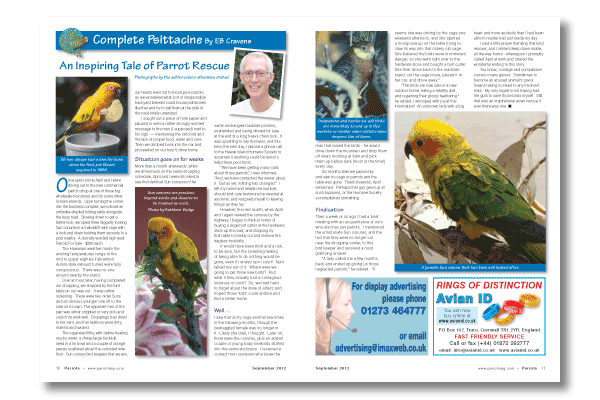
An Inspiring Tale of Parrot Rescue
Once upon a time April and I were driving out to the new commercial park to shop at one of those big wholesale box stores and do some other in-town errands. Upon turning the corner into the business complex, we noticed an umbrella-shaded folding table alongside the busy road. Slowing down to get a better look, we spied three raggedy looking Sun conures in a makeshift wire cage with a lock and chain holding them securely to a post nearby. A clumsily worded sign read: Parrots For Sale - $250 each.
The Hawaiian weather made the existing temperatures range in the mid to upper eighties Fahrenheit. Automobile exhaust fumes were fully conspicuous. There was no-one around nearby the stand.
Over an hour later, having completed our shopping, we stopped by the bird table on our way out. It was rather sickening. There were two older Suns and an obvious younger one off to the side on its own. The apparent hen of the pair was either crippled or very sick and could not walk well. Droppings had dried to her vent, and her feathers were dirty, matted and twisted.
Read more in the magazine…
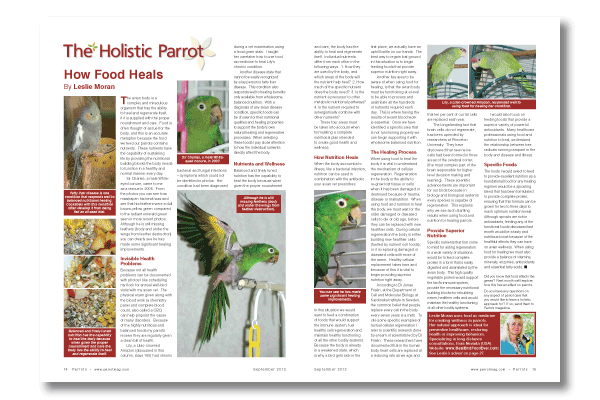
How Food Heals
The avian body is a complex and miraculous organism that has the ability to heal and regenerate itself, if it is supplied with the proper nourishment and care. Food is often thought of as fuel for the body, and this is an accurate metaphor because the food we feed our parrots contains nutrients. These nutrients have the capability of sustaining life by providing the nutritional building blocks the body needs to function in a healthy and normal manner every day.
Sir Charles, a male White-eyed conure, came to me as a rescue in 2006. From the photos you can see how misshapen his beak was and see that his feathers were a dull brown-yellow green compared to the radiant emerald green seen in more recent photos. Although he is still missing feathers (body and under the wings from feather destruction) you can clearly see he has made some significant healing improvements.
Read more in the magazine…
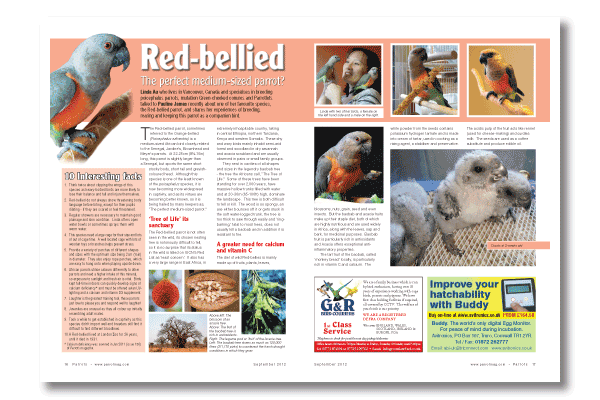
Linda Au who lives in Vancouver, Canada and specialises in breeding poicephalus parrots, mutation Green-cheeked conures and Parrotlets talked to Pauline James recently about one of her favourite species, the Red-bellied parrot, and shares her experiences of breeding, rearing and keeping this parrot as a companion bird.
The Red-bellied parrot, sometimes referred to the Orange-bellied (Poicephalus rufiventris) is a medium-sized African bird closely-related to the Senegal, Jardine’s, Brownhead and Meyer’s parrots. At 22-25cm (8½-10in) long, this parrot is slightly larger than a Senegal, but sports the same short stocky body, short tail and greyish-coloured head. Although this species is one of the least known of the poicephalus species, it is now becoming more widespread in captivity, and as its virtues are becoming better known, so it is being hailed by many keepers as, “The perfect medium-sized parrot.”
Read more in the magazine…
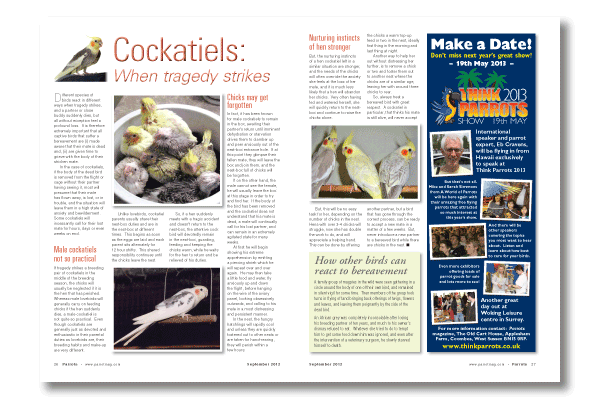
Different species of birds react in different ways when tragedy strikes, and a partner or close buddy suddenly dies, but all without exception feel a profound loss. It is therefore extremely important that all captive birds that suffer a bereavement are (i) made aware that their mate is dead and, (ii) are given time to grieve with the body of their stricken mate.
In the case of cockatiels, if the body of the dead bird is removed from the flight or cage without their partner having seeing it, most will presume that their mate has flown away, is lost, or in trouble, and the situation will leave them in a high state of anxiety and bewilderment. Some cockatiels will incessantly call for their lost mate for hours, days or even weeks on end.
Read more in the magazine…
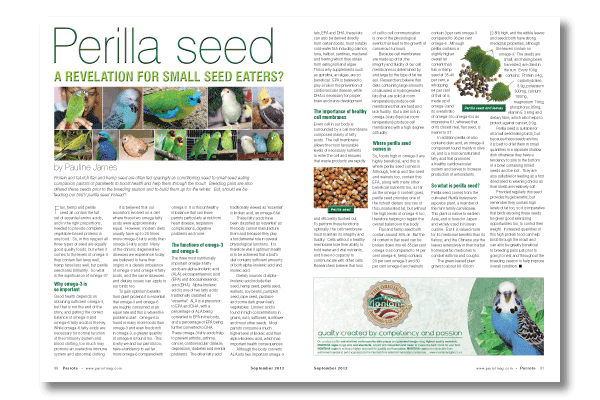
by Pauline James. Protein and fat-rich flax and hemp seed are often fed sparingly as conditioning seed to small seed eating companion parrots or parakeets to boost health and help them through the moult. Breeding pairs are also offered these seeds prior to the breeding season and to build them up for the winter. But, should we be feeding our birds’ perilla seed instead?
Flax, hemp and perilla seed all contain the full set of essential amino acids, and in the right proportions, needed to provide complete vegetable-based proteins in one food. So, in this respect all three types of seed are equally good quality foods, but when it comes to the levels of omega-3 they contain flax fares well, hemp fares less well, but perilla seed fares brilliantly. So what is the significance of omega-3?
Read more in the magazine…





